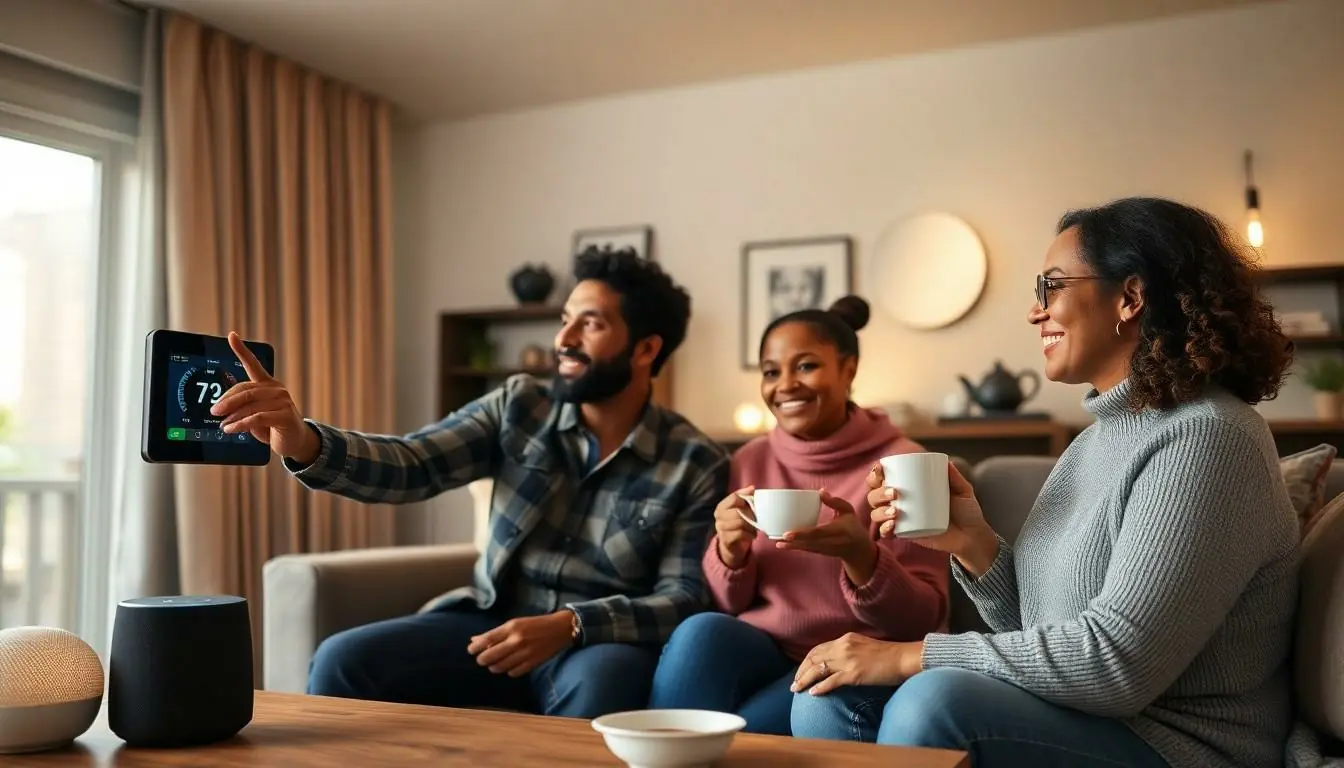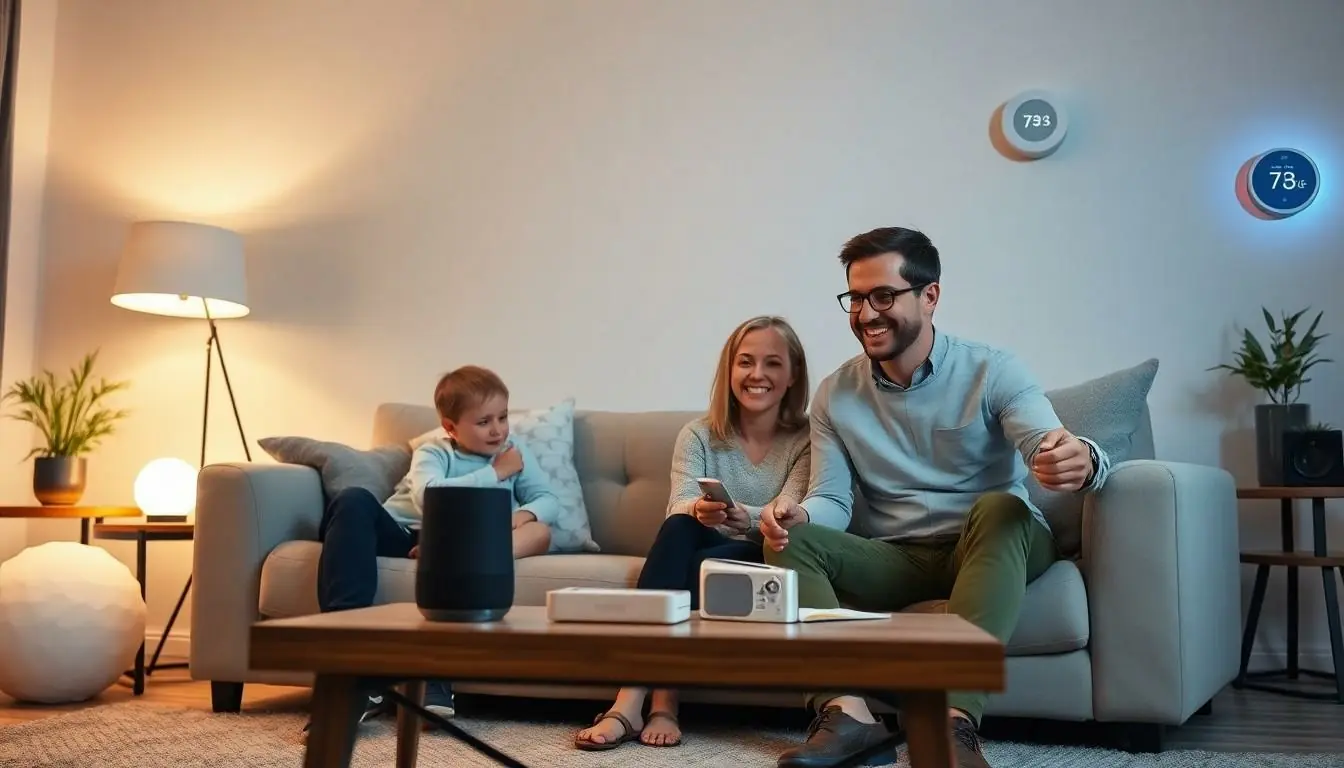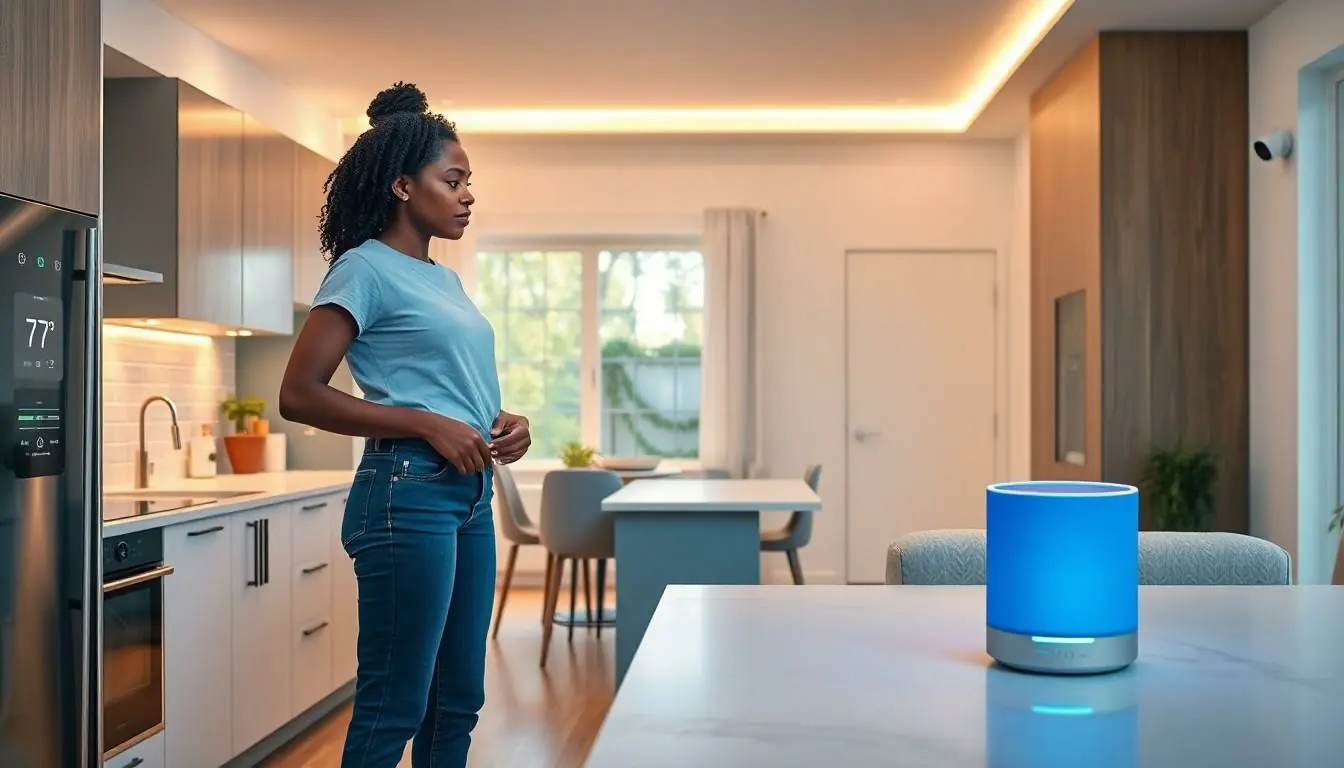Imagine walking into your home and having it greet you like an old friend. Lights flicker on, the thermostat adjusts to your ideal temperature, and your coffee brews itself—all before you even kick off your shoes. Welcome to the world of smart home automation, where technology meets convenience in a way that makes even your cat a little jealous.
Gone are the days of fumbling with light switches or wondering if you left the oven on. With a few simple devices, homes transform into intelligent havens that anticipate needs and simplify daily routines. Whether it’s turning off the lights from the couch or scheduling the vacuum to clean while you binge-watch your favorite series, smart home automation makes life feel like a sci-fi movie—minus the alien invasions. Get ready to embrace a future where your home does the heavy lifting, leaving you free to enjoy the good stuff.
Table of Contents
ToggleWhat Is Smart Homes Automation?
Smart home automation refers to the integration of technology into residential environments, enabling homeowners to control various systems remotely. Lighting, security, heating, and appliances connect to a central smart hub, streamlining management. These automated features contribute to increased energy efficiency, enhancing sustainability within homes.
Users interact with devices through smartphones, tablets, or voice commands, creating an intuitive experience. For example, homeowners can adjust their thermostats or turn on their security cameras from anywhere. This remote access fosters peace of mind, as individuals stay informed about their home’s status.
Additionally, smart homes often incorporate sensors and smart devices that learn resident preferences. Thermostats can automatically adjust based on patterns, mixing comfort with energy savings. Automation simplifies daily tasks and promotes convenience, allowing residents to focus on more important activities.
Integration with virtual assistants offers voice control, making operation seamless. Individuals can give commands like “turn on the lights” or “lock the doors,” providing a hands-free experience. Voice-activated technology streamlines interactions, underscoring the futuristic appeal of smart homes.
Security remains a top priority for many homeowners. Smart locks, security cameras, and alarms help protect properties while offering real-time alerts and notifications. Remote surveillance capabilities enhance safety, giving peace of mind through constant monitoring.
Overall, smart home automation plays a pivotal role in modern living. It transforms conventional houses into interconnected ecosystems, where convenience reigns, and everyday tasks become effortless. This innovative approach to home management ultimately improves quality of life, making routines more efficient and enjoyable.
Benefits of Smart Homes Automation

Smart home automation offers numerous advantages that enhance daily living and efficiency. These benefits stem from advanced technology integration, making homes safer, more efficient, and ultimately more comfortable.
Enhanced Security Features
Enhanced security features form a core benefit of smart home automation. Smart locks allow remote access management and can notify homeowners of unauthorized entry attempts. Surveillance cameras provide real-time monitoring and alerts, enabling immediate action when necessary. Integration of motion sensors detects unusual activity and can trigger notifications on mobile devices, ensuring peace of mind. Homeowners often appreciate the ability to monitor their property from anywhere, reinforcing a sense of safety.
Energy Efficiency
Energy efficiency gains occur through smart home automation technologies. Smart thermostats optimize heating and cooling by learning user schedules and preferences, reducing energy waste. LED lighting systems adjust intensity based on occupancy and time of day, further conserving electricity. Homeowners who utilize these systems typically see a reduction in utility bills. Smart appliances also operate at ideal times to avoid peak energy charges, maximizing efficiency while minimizing environmental impact.
Convenience and Comfort
Convenience and comfort transform daily routines thanks to smart home automation. Homeowners control various systems through single interfaces, allowing for seamless adjustments. Voice commands enable hands-free operation of lights, thermostats, and entertainment systems. Automating everyday tasks, such as brewing coffee or adjusting temperatures, streamlines routines significantly. Many users find that personalized settings cater to their specific lifestyle preferences, fostering a more enjoyable living environment.
Popular Smart Home Devices
Smart home devices enhance convenience and functionality, allowing homeowners to create customized environments tailored to their needs. Several popular categories of smart home devices include smart speakers, thermostats, and lighting systems.
Smart Speakers and Assistants
Smart speakers offer voice-activated control of various home systems. Notable brands like Amazon Echo and Google Nest provide seamless integration with smart devices. Homeowners can play music, check the weather, and control lights using simple voice commands. These devices enable users to manage day-to-day tasks hands-free. Assistant features also allow for setting reminders or creating shopping lists, enhancing overall efficiency in managing home life.
Smart Thermostats
Smart thermostats, such as Nest and Ecobee, optimize home heating and cooling. These devices analyze user behavior to create personalized schedules, ensuring comfort while reducing energy consumption. Features like remote access via smartphone apps enable users to adjust temperatures from anywhere. Many models also provide reports on energy usage, offering insights for further efficiency improvements. Installing a smart thermostat often results in lower utility bills and a reduced carbon footprint.
Smart Lighting Systems
Smart lighting systems allow for complete control of home illumination. Homeowners can adjust brightness and color temperatures using mobile apps or voice commands. Brands like Philips Hue and LIFX offer versatile lighting options, including programmable schedules and scenes. These systems support energy efficiency by allowing lights to automatically turn off when rooms are vacant. Implementing smart lighting can enhance ambiance during different activities and improve overall home security with features like automated schedules mimicking occupant presence.
Challenges and Considerations
Smart home automation brings various challenges and considerations that users need to address. Understanding these factors aids homeowners in making informed decisions.
Cost of Implementation
Implementing smart home automation involves significant costs. Budgeting for devices, installation, and compatibility with existing systems is crucial. Homeowners can expect to spend anywhere from $1,000 to $3,000 on basic setups. Ongoing expenses, like subscription services for cloud storage or premium features, can add to the initial investment. Evaluating long-term savings on energy bills may offset these costs, providing financial benefits over time.
Privacy and Security Concerns
Privacy and security represent considerable concerns for smart home users. Devices often collect data, raising questions about how this information is stored and used. Securing Wi-Fi networks and regularly updating device firmware helps mitigate risks. Hackers targeting smart homes can exploit vulnerabilities, leading to unauthorized access. Homeowners must prioritize security measures, such as two-factor authentication and strong passwords, to safeguard personal information and maintain control over their homes.
Future Trends in Smart Homes Automation
Emerging technologies drive the future of smart home automation. Integration of Artificial Intelligence (AI) enhances predictive capabilities. Systems equipped with AI learn resident habits, optimizing energy usage and comfort.
Voice control technologies continue to evolve, providing users with intuitive experiences. Home systems respond to natural language commands, making interactions simpler. Device coordination increases, enabling seamless communication among smart appliances.
Increased connectivity is expected, with more devices utilizing Internet of Things (IoT) networks. Smart home ecosystems will include everything from refrigerators to irrigation systems. Interoperability among different brands is becoming a priority for consumers.
Data analytics plays a crucial role in smart home advancements. Users gain insights into their energy consumption patterns, helping them make informed decisions. Analyzing behavior also allows for personalized automation solutions tailored to individual lifestyles.
Cybersecurity remains a significant concern in smart home automation. Manufacturers focus on enhancing security measures to protect user data. Regular firmware updates and robust encryption protocols are essential for safeguarding devices.
Sustainability features will be increasingly prevalent in smart home products. Energy-efficient devices contribute to eco-friendly living while reducing utility costs. Homeowners prioritize solutions that balance technology and environmental responsibility.
Lastly, remote accessibility expands further with advancements in mobile applications. Homeowners can monitor and control systems from anywhere in real time. This capability boosts peace of mind, allowing effective management of home environments.
Smart home automation is reshaping how people experience their living spaces. By integrating technology into daily routines, homeowners can enjoy unprecedented convenience and control. The ability to manage everything from lighting to security systems through a central hub enhances comfort while promoting energy efficiency.
As advancements continue, the future of smart homes looks promising. Emerging technologies will further refine user interactions and optimize energy use. While challenges like costs and privacy concerns exist, the benefits of smart home automation far outweigh the drawbacks. This evolution in residential living not only simplifies tasks but also enriches overall quality of life, making every day more enjoyable.







